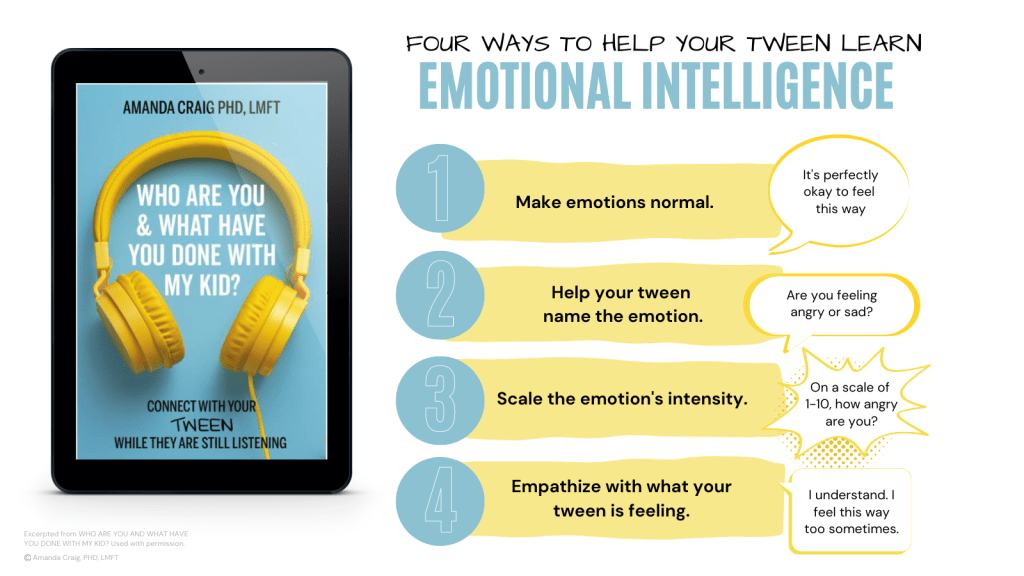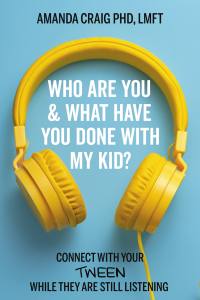Who Are You and What Have You Done with My Kid?
Some tweens blow their top. Others hold it all in. Others become anxious or withdrawn. Most tweens are some combination of these. Regardless, all of it points to the flood of emotion they are experiencing and how unsure they are about what to do with it.
Here are four practical steps to helping your tween manage their emotions:
1. Make emotions normal.
One of the best things we can do for our tween is help them understand that emotions are natural, everyone has them—the happy, the sad, the light, the heavy. They are part of life, and there is as wide a range of emotions as there are experiences to react to. This is where emotional awareness begins. We want to make sure our tween knows that it is okay to feel angry, sad, overwhelmed, or anxious, and to feel happy, calm, and confident. We should be grateful for the trickier emotions we have. They give us a chance to go deeper as human beings and make our lives more interesting.

2. Help your tween name the emotion.
Feelings cannot be measured. They can only be described. When our tween puts words to the feelings their emotions are triggering, they start to learn the very complicated and powerful process of self-awareness. Tweens have a lot of emotions—many they’ve not felt before—and they lack the words to articulate them. They are embarrassed and often self-conscious talking about their thoughts, because they fear they might explain them poorly or get the wrong reaction. They’re in uncharted waters, and they feel insecure. As a result, many tweens won’t even try to talk about any of this.
As their parent, you can help them attach words to their emotions by offering suggestions for what they could be feeling. For example, we might say:
- “I wonder if you were embarrassed by what the teacher said to you in front of the class?”
- “You were really angry earlier when we spoke in your room. Are you still that mad or are you frustrated?”
- “Your coach gave you a really nice compliment about your performance. Does that feel good to hear?”
- “What a good life lesson; you tried something hard and although it didn’t turn out like you wanted, do you think you learned a couple things along the way? That must feel good, no?”
3. Scale the emotion’s intensity.
One of the most effective strategies to measure the intensity of emotions then manage them intentionally is a 1-to-10 scale: 1 to 3 are small emotions, 4 to 6 are the medium, more distracting emotions, 7 to 9 are the really big emotions that interfere with the ability to concentrate, 10 covers the extreme behaviors.
- When our tween is at 1 to 3 on the scale, we are typically talking, exploring ways to express our emotions and keep them under control or regulated.
- Levels 4 to 6 is when emotions are starting to heat up (anger is flaring or sadness is bringing them down.) This is the best time to interject to slow the emotion, bring our tween back to the moment we are in.
- Once our tween reaches 7 or above on the scale, their nervous system has released messages to their body, and now it is involved. At this point, we have to let the body run its course before we can intervene.
4. Empathize with what your tween is feeling.
Conflict with a teacher, disagreements with a friend or teammate, test anxiety, or underperforming in sports—all can be devastating for tweens. We know that. As adults, we also know these problems are peanuts in comparison to the bigger issues we face as life goes on. Still, we must remember this is the first time our tween is experiencing these things, and they often feel unsure, insecure, overwhelmed, or physically ill because of them. We must also keep this in mind when their emotions run hot or they are hard to reach and we find ourselves getting angry, frustrated, or worried about them.
If we can hold our own reactions, table any concerns about their intense emotions—regardless of how inappropriate or out of proportion they may be—and focus instead on what they are experiencing and what triggered the experience… if we can really listen, our tween will feel reassured, secure, and more confident in themselves.
This information originally appeared in the book Who Are You and What Have You Done with My Kid? by Amanda Craig. To continue reading from the book, download a free chapter by clicking here.
How do we keep our kids close while cultivating the confidence they’ll need to grow up? How do we navigate the inevitable dips, divides, and potholes? Where do we find the strength, self-awareness, and wisdom that amount to a path forward?
Despite the parenting opportunities in the tween years, we often spend time focused on academics and the social concerns of elementary school then quickly pivot to worries about safety, drugs, sex and the rebellious behavioral issues of the teen years. We think we’re connecting but we’re not. We miss the neurological explosion that is taking place before us as tweens experience four significant changes that shake them (and us) to their core.
- Their brains are changing.
- They feel and experience emotions they do not recognize.
- They’re hyperaware of themselves.
- They do not know how to express themselves.
Most importantly, parents still have a “seat at the table” to make positive impressions on their tweens as they prepare them for the teenage years.

